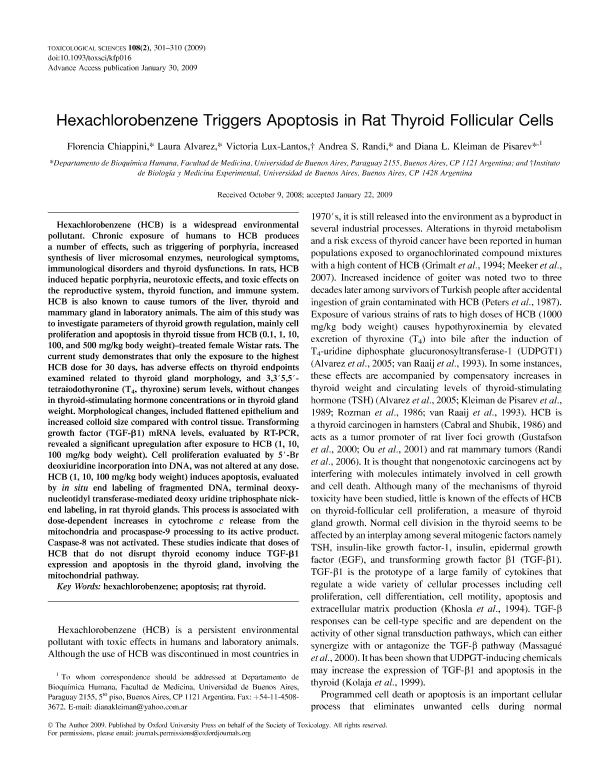Mostrar el registro sencillo del ítem
dc.contributor.author
Chiappini, Florencia Ana

dc.contributor.author
Alvarez, Laura

dc.contributor.author
Lux, Victoria Adela R.

dc.contributor.author
Randi, Andrea Silvana

dc.contributor.author
Kleiman, Diana Leonor

dc.date.available
2017-09-25T19:14:55Z
dc.date.issued
2009-04
dc.identifier.citation
Chiappini, Florencia Ana; Alvarez, Laura; Lux, Victoria Adela R.; Randi, Andrea Silvana; Kleiman, Diana Leonor; Hexachlorobenzene triggers apoptosis in rat thyroid follicular cells; Oxford University Press; Toxicological Sciences; 108; 2; 4-2009; 301-310
dc.identifier.issn
1096-6080
dc.identifier.uri
http://hdl.handle.net/11336/25060
dc.description.abstract
Hexachlorobenzene (HCB) is a widespread environmental pollutant. Chronic exposure of humans to HCB produces a number of effects, such as triggering of porphyria, increased synthesis of liver microsomal enzymes, neurological symptoms, immunological disorders and thyroid dysfunctions. In rats HCB induced hepatic porphyria, neurotoxic effects and toxic effects on the reproductive system, thyroid function and immune system. HCB is also known to cause tumors of the liver, thyroid and mammary gland in laboratory animals. The aim of this study was to investigate parameters of thyroid growth regulation, mainly cell proliferation and apoptosis in thyroid tissue from HCB (0.1, 1, 10, 100, and 500 mg/kg body weight)-treated female Wistar rats. The current study demonstrates that only the exposure to the highest HCB dose for 30 days, has adverse effects on thyroid endpoints examined related to thyroid gland morphology, and 3,3´,5,5´-tetraiodothyronine (T(4,) thyroxine) serum levels, without changes in TSH concentrations or in thyroid gland weight. Morphological changes, included flattened epithelium and increased colloid size compared with control tissue. Transforming growth factor (TGF-beta1) mRNA levels, evaluated by RT-PCR, revealed a significant upregulation after exposure to HCB (1, 10, 100 mg/kg body weight). Cell proliferation evaluated by 5´-Br deoxiuridine (BrdU) incorporation into DNA, was not altered at any dose. HCB (1, 10, 100 mg/kg body weight) induces apoptosis, evaluated by in situ end-labeling of fragmented DNA, TUNEL, in rat thyroid glands. This process is associated with dose-dependent increases in cytochrome c release from the mitochondria and procaspase-9 processing to its active product. Caspase-8 was not activated. These studies indicate that doses of HCB that do not disrupt thyroid economy induce TGF-beta1 expression and apoptosis in the thyroid gland, involving the mitochondrial pathway.
dc.format
application/pdf
dc.language.iso
eng
dc.publisher
Oxford University Press

dc.rights
info:eu-repo/semantics/openAccess
dc.rights.uri
https://creativecommons.org/licenses/by-nc-nd/2.5/ar/
dc.subject
Hexachlorobenzene
dc.subject
Thyroid
dc.subject
Apoptosis
dc.subject
Mitochondria
dc.subject.classification
Bioquímica y Biología Molecular

dc.subject.classification
Medicina Básica

dc.subject.classification
CIENCIAS MÉDICAS Y DE LA SALUD

dc.title
Hexachlorobenzene triggers apoptosis in rat thyroid follicular cells
dc.type
info:eu-repo/semantics/article
dc.type
info:ar-repo/semantics/artículo
dc.type
info:eu-repo/semantics/publishedVersion
dc.date.updated
2017-09-19T18:23:45Z
dc.identifier.eissn
1096-0929
dc.journal.volume
108
dc.journal.number
2
dc.journal.pagination
301-310
dc.journal.pais
Estados Unidos

dc.journal.ciudad
Orlando
dc.description.fil
Fil: Chiappini, Florencia Ana. Universidad de Buenos Aires. Facultad de Medicina. Departamento de Bioquímica Humana; Argentina. Consejo Nacional de Investigaciones Científicas y Técnicas; Argentina
dc.description.fil
Fil: Alvarez, Laura. Universidad de Buenos Aires. Facultad de Medicina. Departamento de Bioquímica Humana; Argentina. Consejo Nacional de Investigaciones Científicas y Técnicas; Argentina
dc.description.fil
Fil: Lux, Victoria Adela R.. Consejo Nacional de Investigaciones Científicas y Técnicas. Instituto de Biología y Medicina Experimental. Fundación de Instituto de Biología y Medicina Experimental. Instituto de Biología y Medicina Experimental; Argentina
dc.description.fil
Fil: Randi, Andrea Silvana. Universidad de Buenos Aires. Facultad de Medicina. Departamento de Bioquímica Humana; Argentina. Consejo Nacional de Investigaciones Científicas y Técnicas; Argentina
dc.description.fil
Fil: Kleiman, Diana Leonor. Universidad de Buenos Aires. Facultad de Medicina. Departamento de Bioquímica Humana; Argentina. Consejo Nacional de Investigaciones Científicas y Técnicas; Argentina
dc.journal.title
Toxicological Sciences

dc.relation.alternativeid
info:eu-repo/semantics/altIdentifier/url/https://academic.oup.com/toxsci/article/108/2/301/1666219/Hexachlorobenzene-Triggers-Apoptosis-in-Rat
dc.relation.alternativeid
info:eu-repo/semantics/altIdentifier/doi/http://dx.doi.org/10.1093/toxsci/kfp016
dc.relation.alternativeid
info:eu-repo/semantics/altIdentifier/pmid/19182106
Archivos asociados
